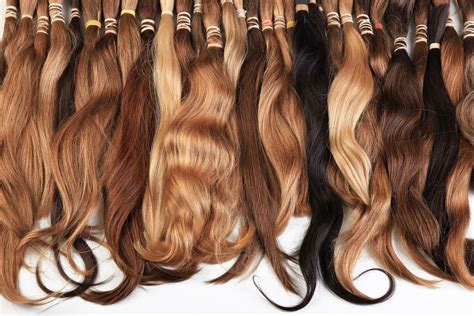Introduction
Clip-in extensions offer a convenient and versatile way to enhance your hair’s volume, length, and style. They allow for quick and easy transformations without the commitment or damage associated with permanent extensions. This article will guide you through the world of clip-in extensions, providing insights on choosing the right type, maintaining them for longevity, and styling them with confidence.

Types of Clip-In Extensions
Remy Hair Extensions
Remy hair extensions are considered the highest quality clip-ins as they maintain the hair’s natural cuticle alignment. This alignment minimizes tangling and ensures a smooth, silky texture. Remy hair extensions come from a single donor, ensuring consistent hair color and texture.
Synthetic Hair Extensions
Synthetic hair extensions are a budget-friendly option that mimics the look and feel of natural hair. They are heat-resistant, allowing for styling with heat tools. However, synthetic hair extensions may be less durable than their Remy counterparts.
Blend Hair Extensions
Blend hair extensions combine both Remy and synthetic hair. They offer a balance between quality and affordability. Blend hair extensions typically have a higher percentage of Remy hair, providing a natural look and feel.
Choosing the Right Clip-In Extensions
Hair Type and Color
When choosing clip-in extensions, consider your natural hair type and color. Matching the texture of your hair to the extensions ensures a seamless blend. If your hair is fine, opt for thinner extensions. Thicker hair requires more volume, so consider fuller extensions. For color matching, choose extensions that closely resemble your hair’s natural shade.
Length and Volume
Determine the desired length and volume you want to achieve. Clip-in extensions come in various lengths, from 12 inches to 26 inches. The number of wefts included in the set will determine the volume. Start with a smaller set of extensions and gradually add more as needed.
Attachment Type
Clip-in extensions come with different attachment types. Snap-on clips are the most common and easiest to use. U-pinned clips provide a more secure hold. Claw clips are another option, offering a combination of comfort and hold.
Maintaining Clip-In Extensions
Regular Washing
Wash your clip-in extensions regularly, approximately every 10-12 uses. Use lukewarm water and a gentle sulfate-free shampoo. Condition the extensions to maintain their smoothness.
Avoid Heat Damage
Limit the use of heat styling tools on your clip-in extensions. High heat can damage the hair shaft, leading to dryness and breakage. When using heat, apply a heat protectant spray to minimize damage.
Detangling and Storage
Brush your extensions regularly to prevent tangles. Store them flat or hanging to avoid matting. Use a brush specifically designed for extensions to reduce breakage.
Styling with Clip-In Extensions
Tips and Tricks
- Start by sectioning your hair to create a natural look.
- Use smaller wefts for a more subtle transformation.
- Secure the clips tightly but avoid placing them too close to your scalp.
- Style your natural hair and extensions together to blend them seamlessly.
- Experiment with different colors and textures to create unique looks.
Step-by-Step Approach
- Prepare your hair: Wash and condition your natural hair.
- Section your hair: Separate the top section of your hair with a clip.
- Attach the extensions: Start by clipping the bottom wefts close to your scalp. Work your way up, adding wefts as needed.
- Secure the clips: Ensure the clips are firmly attached and hidden beneath your natural hair.
- Style your hair: Brush and style your natural hair and extensions together to create a cohesive look.
Pros and Cons of Clip-In Extensions
Pros
- Quick and easy to apply and remove.
- Versatile, allowing for various styling options.
- Non-damaging, unlike permanent extensions.
- Cost-effective compared to salon-installed extensions.
Cons
- May require regular maintenance to maintain quality.
- Can be noticeable if not applied or styled properly.
- May not be suitable for all hair types, especially fine hair.
Comparative Table: Clip-In Extension Types
| Type | Texture | Durability | Cost |
|---|---|---|---|
| Remy Hair | Silky, natural | High | High |
| Synthetic Hair | Mimicked, heat-resistant | Moderate | Low |
| Blend Hair | Balanced, cost-effective | Moderate | Moderate |
Comparative Table: Clip-In Extension Lengths
| Length | Versatility | Volume |
|---|---|---|
| 12-16 inches | Subtle transformation, everyday wear | Moderate |
| 18-20 inches | Noticeable length, special occasions | Medium |
| 22-26 inches | Dramatic transformation, glamour events | High |
Comparative Table: Clip-In Extension Attachment Types
| Type | Hold Strength | Comfort | Visibility |
|---|---|---|---|
| Snap-on Clips | Moderate | High | Low |
| U-pinned Clips | High | Moderate | Moderate |
| Claw Clips | Moderate | High | High |
Maintenance Table: Regular Care for Clip-In Extensions
| Task | Frequency | Importance |
|---|---|---|
| Wash | Every 10-12 uses | Prevents build-up and tangles |
| Condition | After every wash | Maintains smoothness and shine |
| Detangle | Regularly | Prevents breakage and matting |
| Heat Protect | Before using heat styling tools | Reduces damage |
Conclusion
Clip-in extensions offer a transformative hair solution that empowers you to embrace a variety of styles without the long-term commitment of permanent extensions. By carefully choosing the right type, maintaining them properly, and styling them with confidence, you can achieve a seamless and glamorous look. Whether you desire a subtle enhancement or a dramatic transformation, clip-in extensions provide a convenient and cost-effective way to elevate your hair’s beauty.
